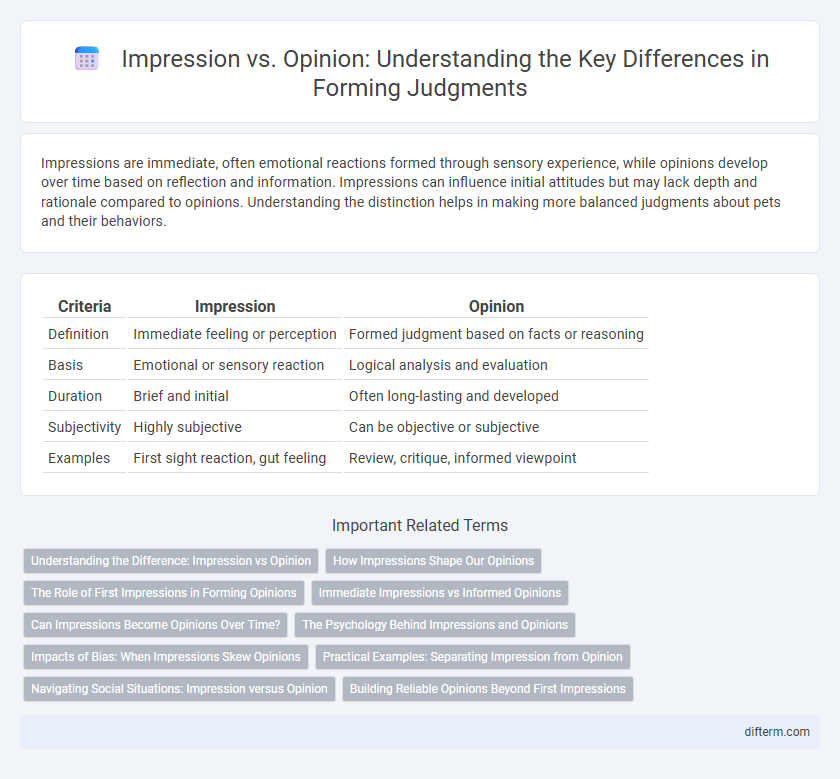Impressions are immediate, often emotional reactions formed through sensory experience, while opinions develop over time based on reflection and information. Impressions can influence initial attitudes but may lack depth and rationale compared to opinions. Understanding the distinction helps in making more balanced judgments about pets and their behaviors.
Table of Comparison
| Criteria | Impression | Opinion |
|---|---|---|
| Definition | Immediate feeling or perception | Formed judgment based on facts or reasoning |
| Basis | Emotional or sensory reaction | Logical analysis and evaluation |
| Duration | Brief and initial | Often long-lasting and developed |
| Subjectivity | Highly subjective | Can be objective or subjective |
| Examples | First sight reaction, gut feeling | Review, critique, informed viewpoint |
Understanding the Difference: Impression vs Opinion
Impression refers to an immediate, often subconscious reaction formed through sensory perception or brief exposure, whereas opinion is a more deliberate and reasoned judgment developed after reflection and analysis. Impressions are typically emotional and fleeting, shaping initial attitudes, while opinions are cognitive constructs influenced by knowledge, experience, and critical thinking. Recognizing the distinction between impression and opinion enhances clarity in communication and decision-making by distinguishing instinctive responses from informed beliefs.
How Impressions Shape Our Opinions
Impressions serve as the initial sensory and emotional inputs that influence how we perceive people, situations, and information. These early cognitive signals activate neural pathways that form the foundation for our opinions by filtering and interpreting subsequent experiences. Over time, strong impressions solidify into lasting opinions, demonstrating the powerful role of immediate perception in shaping belief systems.
The Role of First Impressions in Forming Opinions
First impressions significantly influence the formation of opinions by providing an immediate, often subconscious, assessment that shapes subsequent judgment. These initial perceptions act as cognitive shortcuts, affecting how new information is interpreted and integrated into existing beliefs. Understanding the psychological mechanisms behind first impressions can help mitigate bias and promote more balanced opinion formation.
Immediate Impressions vs Informed Opinions
Immediate impressions are often formed within seconds based on surface-level cues such as facial expressions and body language, relying heavily on subconscious processing. Informed opinions develop through the assimilation of verified facts, critical analysis, and broader context, leading to more rational and balanced judgments. Understanding the distinction between fleeting impressions and well-founded opinions is crucial for effective decision-making and meaningful discourse.
Can Impressions Become Opinions Over Time?
Impressions form rapidly through initial sensory or emotional responses, providing immediate but often superficial judgments. Over time, repeated experiences and critical reflection deepen these impressions, transforming them into well-informed opinions grounded in evidence and reasoning. This evolution highlights the dynamic nature of human cognition, where fleeting impressions can mature into stable, nuanced viewpoints.
The Psychology Behind Impressions and Opinions
Impressions are immediate, often subconscious reactions shaped by visual cues, body language, and tone, rooted in the brain's rapid processing systems. Opinions develop through deliberate cognitive evaluation, influenced by personal beliefs, experiences, and deeper analysis of facts. Understanding the psychological mechanisms that differentiate these mental constructs helps clarify how attitudes are formed and evolved over time.
Impacts of Bias: When Impressions Skew Opinions
Bias in impressions significantly distorts opinions by selectively filtering information to reinforce preexisting beliefs, leading to subjective rather than objective judgments. This cognitive distortion increases the likelihood of stereotyping, confirmation bias, and misinterpretation of reality, ultimately compromising decision-making accuracy. Understanding the neurological and psychological mechanisms behind biased impressions is crucial for mitigating their influence on opinion formation.
Practical Examples: Separating Impression from Opinion
Impression forms through immediate sensory encounters, such as the warmth felt during a handshake, while opinion develops from reflective judgment, like deciding a colleague is trustworthy based on consistent behavior. For example, seeing a messy workspace creates a negative impression, but forming an opinion requires understanding the reasons behind the mess, such as a tight project deadline. Distinguishing these concepts improves communication by preventing hasty conclusions and fostering fair evaluations rooted in evidence.
Navigating Social Situations: Impression versus Opinion
Impressions shape initial perceptions in social situations, often influenced by visual cues and unconscious biases, while opinions develop through deeper understanding and critical evaluation. Navigating social interactions requires balancing immediate impressions with reflective opinions to avoid misjudgments and foster genuine connections. Recognizing the distinction between transient impressions and formed opinions enhances emotional intelligence and communication effectiveness.
Building Reliable Opinions Beyond First Impressions
First impressions often capture surface-level details, but building reliable opinions requires deeper analysis and critical thinking. By evaluating evidence, considering multiple perspectives, and questioning initial judgments, one can develop a more accurate and well-founded understanding. This process strengthens decision-making and fosters informed opinions that reflect true insights rather than fleeting impressions.
impression vs opinion Infographic

 difterm.com
difterm.com